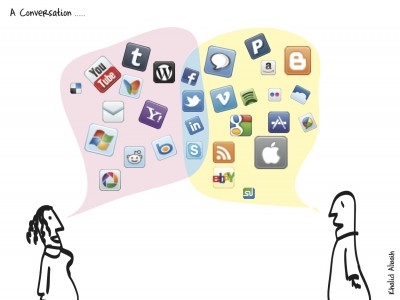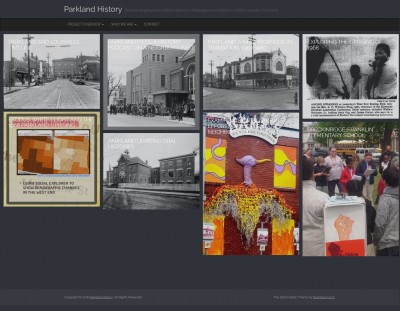Digital community engagement across the divides
20 April 2016 – Lara Kelland
"Chasing the Frontiers of Digital Technology" responses, public engagement, community history, digital history, The Public Historian, TPH 38.1, digital divide

Image credit: A Conversation, Khalid Albaih
In 2008, the Journal of American History published a conversation among several historians regarding the future of digital history. William G. Thomas III said, “We might imagine a more proximate collaboration in which historians team up with [community] groups. The Web 2.0 movement might allow historians and the public to make history together rather than separately. The professional barriers are significant, but our professional relevance is also at stake in the digital age.” [1]
Thomas spoke primarily to academic historians, to those working in the ivory tower who had begun to venture down the road into public history via digital tools. But his optimism regarding the participatory potential within digital tools surely echoes public history’s embrace of digital work and fundamental commitment to collaborative history making.
Andrew Hurley’s thought-provoking article in the February 2016 issue of The Public Historian provides public history practitioners a glimpse into one innovative project that uses digital tools for such collaboration in place-based history. This work offers potential for digitally inflected (to borrow a term from Jeff McClurken) public historians to advance the field’s promotion of community engagement and the toolkit of shared authority. His analysis of the Virtual City Project offers an account of successes and failures in using immersive environments to provoke conversation about the past, present, and future of a historic neighborhood.
Hurley’s account usefully engages the question of community agency in the planning process, especially as it pertains to historic nomination standards. Restoration Group’s innovative strategy for crossing a digital divide (which Hurley insightfully points out is as much about culturally specific digital behavior as it is access to hardware) involved docent-led explorations in a community space. Such creative practices are central to the kind of inclusive work that public historians seek to do with digital tools.
After reading the piece, I wondered about the potential impact of this technology on community and individual memory. In my experience with community-based history projects, visuals as low-tech as photocopied newspaper images can elicit a wealth of memories for long-time community residents, and immersive environments, such as 3D imaging, ought to prove much more evocative. Indeed, Hurley mentions that “members of an older generation who had some familiarity with the neighborhood” brought their own memories into the group dialogues. I suspect that 3D modeling of historical places would provoke a flood of memories in most communities. Such visualization holds great potential, it seems to me, in nurturing recollections in oral history projects and other public history endeavors—especially as we strive to be a part of community revitalization that also nurtures long-time residents.
One of the most vexing and important challenges facing those doing redevelopment work in urban historical neighborhoods is the process of gentrification. As public historians, we must be mindful of the ways that market forces respond to our work, especially when it means the potential displacement of working-class communities or people of color. The Virtual City Project successfully brought a cross section of the neighborhood into the planning process, an important first step towards the goal of nurturing historic resources and developing interpretive projects while also protecting more vulnerable members of the community. Perhaps the conversation inspired by this project can extend such dialogue into other projects that struggle with digital community engagement.
Parkland History Project

Homepage of Parkland History Project. Screenshot credit: Lara Kelland
In May 1968, the Parkland neighborhood of Louisville, KY, was the site of an urban disorder. Like so many other cities, activists and residents fed up with police brutality took to the streets to protest a variety of frustrating issues: the slow pace of policy change in response to the activism of the civil rights movement, displacement policies such as urban renewal, the assassination of Dr. Martin Luther King Jr., and other social, economic, and cultural problems. Currently, the Parkland neighborhood struggles with a host of issues that are common in many urban neighborhoods comprised of low-income residents and people of color. Population drain, food deserts, crime, empty lots, and a lack of services inspire uplift efforts such as community garden projects, grassroots arts initiatives, and myriad efforts by a dedicated group of local activists and social service organizations. Indeed, we imagine our history work as a complement to such revitalization efforts
For the past two years, I have directed the Parkland History Project as part of my graduate courses and my own research efforts in the public history program at the University of Louisville. In our work, we have used oral histories to ensure that a diverse set of experiences is inscribed into the historical record. In partnership with the Parkland Neighborhood Improvement Association, we have conducted over thirty-five oral history interviews and have incorporated these memories and archival documents into a variety of digital history projects and student-curated exhibits.
Although traditional archival documents comprise a portion of the sources used in the project, oral histories and lived memory make up a significant portion of the historical materials through which we are telling neighborhood and Black Freedom Movement history. While this approach should ensure that we foreground community members’ voices, we have also sought to gain community input at the project-curation level. So far, however, we have failed to secure meaningful input in response to interpretive projects.
During the oral history interviews in 2014, narrators responded in a wide variety of ways to the question of whether the events of May 1968 ought to be remembered as a “riot,” “uprising,” or “disturbance,” sometimes providing their own terms. As students in my public history courses at the University of Louisville have worked with the oral histories as raw material for interpretive projects, they have extended this terminology debate into their work in an effort to honor the lived experiences of residents. In most cases, they have handled the matter with sensitivity and have managed to represent multiple viewpoints. To this end, we feel that the project has successfully shared authority at the level of co-creating oral histories.
Yet our attempts at gaining community input into the final projects have generated little constructive criticism. A community survey asking for responses to the project website that features various student projects garnered few responses, as have similar invitations we have issued on social media. Those who have contacted us have been supportive of the digital work we have done, but our hopes for engaged and sustained dialogue about the neighborhood’s past, present, and future have yet to materialize. We plan to more richly engage digital maps as we continue the project, but we will have to be innovative to ensure that such projects elicit a deep level of community participation.
Like Hurley, we have speculated that the digital divide in its many forms has contributed to this silence. As we move into the second half of the project, we plan to increase our community engagement strategies to include more programming in the neighborhood, and we will likely take cues from the successful strategy deployed by the Virtual City Project to blend face-to-face methods with digital tools. The “build it and put it on the web and they will come” model for digital history is insufficient, but I feel confident that if we continue to share strategies for civic engagement in the digital era, we will craft a set of practices that will further the goals of democratized cultural production.
~ Lara Kelland is a scholar of twentieth-century social movements and collective memory practices. She teaches public and US history at the University of Louisville.
[1] William G. Thomas III, “Interchange: The Promise of Digital History,” Journal of American History 95, no. 2 (2008): 472.



